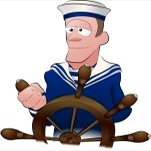
CruiseShipOfficer
New York, NY
Male, 33
I have worked as a deck officer on large cruise ships for almost a decade. When standing watch on the bridge for eight hours a day, I was directly responsible for the safety and navigation of the vessel. In addition, in my roles as Safety Officer and Chief Officer, I have had duties outside of the bridge regarding emergency response and procedures.
It depends on your rank. A few deck officers will be in charge of some of the regular lifeboats with passengers. But on a ship with, say, 20 lifeboats, there aren't 20 deck officers to be in charge of each lifeboat. (In this case, other trained (and certified) people- Quartermasters, engineering officers, etc- will be in charge of the boat, along with several other crew members that will also help man the boat.) In addition, when you give the order to abandon ship, losing all of your officers to go man the lifeboats means you have less people onboard to ensure critical elements of the ship and evacuation are going as they should-- so a core team might remain behind until all the boats and rafts are away, and then that core team will go in the last liferaft(s). But each company has a different policy- and a different emergency response structure- and so do it a different way. But the general answer is some officers will go in lifeboats with passengers, and others may wait until the end and go in the last liferafts after the rest of the evacuation is complete.
I wouldn't say any really close calls, no. There have been, however, many moments where my blood pressure has gone up and my heart rate increased, for sure, or times where if the situation was not handled correctly and promptly, there could have been more serious consequences. But I've seen fires- albeit minor ones that are out quickly- power outages, medical evacuations, big storms, and mechanical failures. But well trained crews can and do respond effectively to these situations to ensure they don't become 'incidents.' And being responsible for the safety of these ships is stressful- I always felt when I walked down the gangway at the end of a contract onboard something like relief that nothing major had happened. I definitely believe that highly qualified crew is vital for manning these new, huge, technologically advanced ships and that cruise lines need to focus on attracting and retaining top talent.
Truthfully, I have no idea-- but the number is very small. Whenever it happens, there is usually a fair amount of media attention, so the frequency might seem higher than people think. The bottom line is you really have to try hard to fall off a ship. Regulations dictate the minimum height of railings, and they are high enough you won't just accidentally slip and suddenly find yourself in the sea. To fall off, you essentially have to be doing something pretty stupid- like climbing on a rail- or intentionally throw yourself off. Recovery chances vary depending on how high the person was when they jump and where the ship is-- obviously if you go overboard in the cold North Atlantic, your chances are much slimmer than if it is in the Caribbean. Recovery is therefor not totally out of the condition-- there have been a few cases within the last few years where the ship's crews have successfully recovered passengers who fell overboard.
It really depends on individual companies. Most European/"western" officers will usually work between 6 or 8 months a year. This is often broken down into 3 months on and then 3 months off, or 4 months on and 2 months off. I would say 4 and 2 is probably slightly more common than 3 and 3, at least for cruiseships. Of course, when you are working, you are working 7 days a week without a break, and are always 'on call' even when off the bridge.
Personal Stylist & Life Coach
 What's the difference between a life coach and a therapist?
What's the difference between a life coach and a therapist?
Hairstylist and Makeup Artist
 How much am I supposed to tip my hairstylist?
How much am I supposed to tip my hairstylist?
Fashion Model
 What's the most lucrative type of gig models can book?
What's the most lucrative type of gig models can book?
It depends on the size of the ship, mostly, along with the conditions at that time... Smaller cruise ships on a normal passage out at sea will usually have one qualified officer on watch at any time, along with a lookout, or Quartermaster. But the vast majority of modern cruise ships will have two officers on watch at all times, with at least one lookout/Quartermaster assisting as well. However, if the vessel is in an area where there is more demanding navigation- close to shore, coming into or out of ports, areas in which there is heavy traffic, or during restricted visibility, for instance- the bridge team is supplemented by additional officers. Usually this would be the Staff/Deputy Captain (ie the Second in Command) or the Captain. (Coming into a port, you will often find there are two Officers of the Watch, the Staff Captain, the Captain, and a local harbor pilot.) The standard schedule for bridge officers is 4 hours of watch followed by 8 hours off watch. Some ships vary that routine in order to give officers one period a day where they can get at least 10 hours off, but most ships around the world operate on a 4 hours on, 8 hours off schedule.
As with all these answers, until the report comes out we don't know for sure, and it is all speculation. But we do know the rock opened up a very, very long hole in the side of the ship. Ships are broken into watertight compartments that stretch from the bottom of the ship to a few decks above the waterline. This prevents a hole in one part of the ship from sinking the entire ship-- one watertight compartment would fill but the ship can still easily float. The Concordia was designed so that multiple compartments could be flooded and the ship would still be afloat, but I suspect the damage was just simply too large and the number of compartments penetrated exceeded the number she could still float with. At this point, with water rushing in, the ship began to lose her stability. As to what caused the ship to start listing- it could be a number of factors. Perhaps the ship turned sharply well after a lot of water was in, causing water to rush to one side. It could be any number of reasons because the stability was already compromised. But as the ship began to list, and without power to pump or transfer water to the other side, the situation got progressively worse, and the other design elements in place to keep the ship from listing were probably just not enough to deal with the amount of water in the ship given the size and length of the damage.
Antiquated. What surprises me are the news reports that this was- either formally or informally- the policy at some boats on the Concordia. None of the passenger ships I've worked on have had this rule at all. In fact, it is the opposite-- to keep passengers calm, you want to keep families together. Splitting people up will only make crowd control more difficult.
-OR-
 Login with Facebook
Login with Facebook (max 20 characters - letters, numbers, and underscores only. Note that your username is private, and you have the option to choose an alias when asking questions or hosting a Q&A.)
(A valid e-mail address is required. Your e-mail will not be shared with anyone.)
(min 5 characters)
By checking this box, you acknowledge that you have read and agree to Jobstr.com’s Terms and Privacy Policy.
-OR-
 Register with Facebook
Register with Facebook(Don't worry: you'll be able to choose an alias when asking questions or hosting a Q&A.)